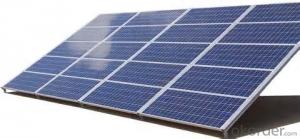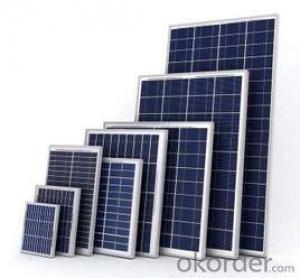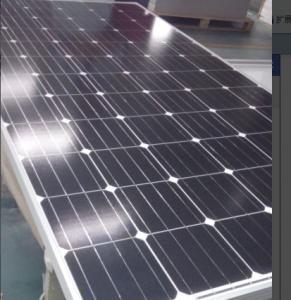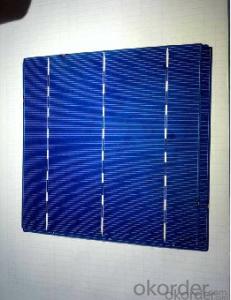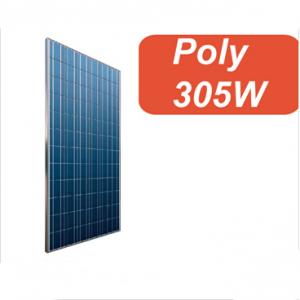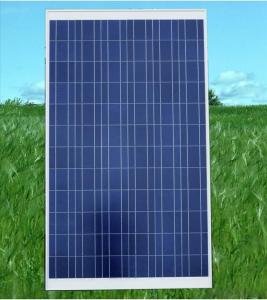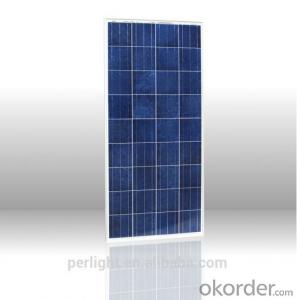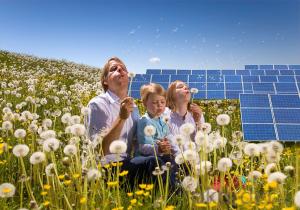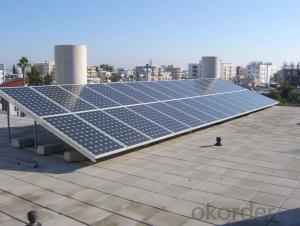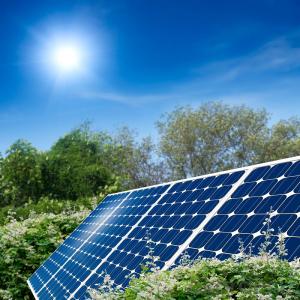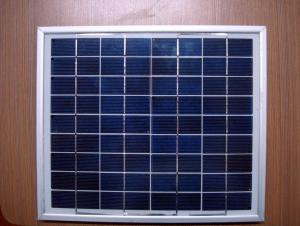High Efficiency Polycrystalline Metal Roofing Solar Panels 305W
- Loading Port:
- China main port
- Payment Terms:
- TT OR LC
- Min Order Qty:
- 1000 watt
- Supply Capability:
- 1000000 watt/month
OKorder Service Pledge
OKorder Financial Service
You Might Also Like
Specification
Introduction of Poly solar panels CNBM
Polycrystalline Solar Panels 305W With High Efficiency
CNBM Solar photovoltaic (PV) Panel is designed for large electrical power requirements. It is the optimal choice for both on-grid and off-grid power systems. CNBM Solar panel offers high performance of power per square foot of solar array. Monocrystalline silicon(c-Si): often made using the Czochralski process. Single-crystal wafer cells tend to be expensive, and because they are cut from cylindrical ingots, do not completely cover a square solar cell module without a substantial waste of refined silicon. Hence most c-Si panels have uncovered gaps at the four corners of the cells.
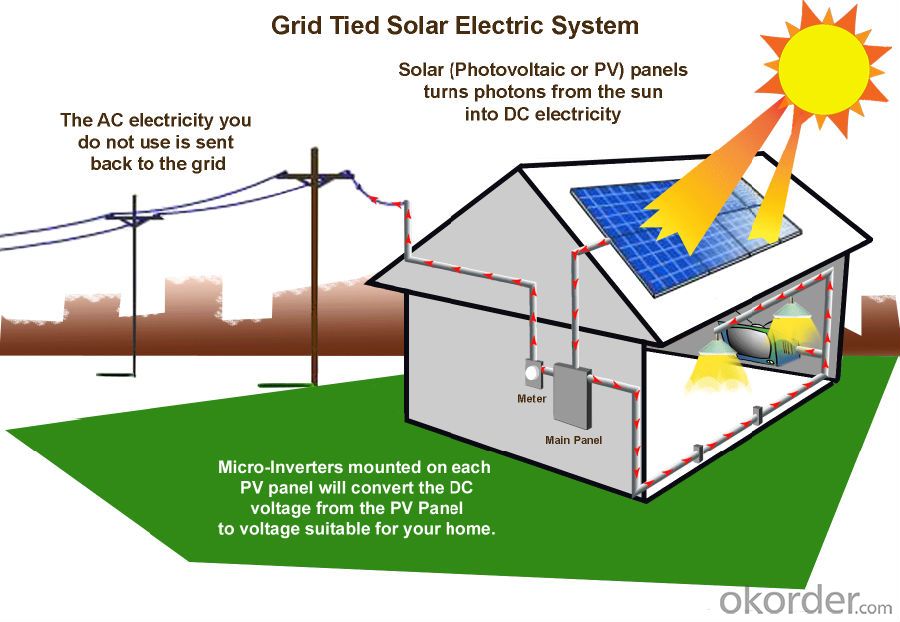
Feature
1.Solar Cell : High efficiency crystalline solar cell. Even if under the weak light, the solar module can produce maximum power output.
2.Tempered glass (toughened glass): Anti-reflecting coating and high transmission rate glass increase the power output and mechanical strength of solar module.
3.EVA and TPT: Using high quality EVA and TPT to prevent destroying and water.
4.Long lifetime: ≥25 years; Less power decrease.
5.Resisting moisture and etching effectively, not effected by geology.
6.The certificate issued by international authority: UL, TUV, IEC, VDE, CE.
Specification
Characteristics of Poly solar panels CNBM | |||||
Max Power Voltage Vmp(V) | 30.3 | 30.8 | 31.1 | 31.4 | 31.85 |
Max Power Current Imp(A) | 7.60 | 7.64 | 7.73 | 7.81 | 7.85 |
Open Circuit Voltage Voc(V) | 36.1 | 36.6 | 37 | 37.3 | 37.68 |
Short Circuit Current Isc(A) | 8.50 | 8.55 | 8.65 | 8.75 | 8.85 |
Max Power Pm(W) | 230W | 235W | 240W | 245W | 250W |
Temperature Coefficient of Cells Poly solar panels CNBM | |
NOCT | 45℃ ± 2℃ |
Temperature Coeffucients of Isc (%/℃) | 0.0492 |
Temperature Coeffucients of Voc (%/℃) | -0.3374 |
Temperature Coeffucients of Voc (%/℃) | -0.4677 |
Mechanical Data of Poly solar panels CNBM | |
Dimension | 1638 × 982 × 40 mm |
Weight | 19.5 kg |
No. of Cells and Connections | 60 (6 ×10) |
Tolerance | 0 ~ + 5 W |
Cell | Monocrystalline Cell 156 × 156 mm |
Packing | 624 Pcs/40ft(H) Container |
Limits of Poly solar panels CNBM | |
Operating Temperature | -40℃ to +85℃ |
Storage Temperature | -40℃ to +85℃ |
Max System Voltage | 1000VDC(IEC) / 600VDC(UL) |
Guarantees of Poly solar panels CNBM | |
Products Guarantee | 12 yrs free from defects in materials and workmanship |
Performance Guarantee | No less than 90% within 10yrs and no less than 80% within 25yrs |
Certificates | TUV(IEC61215&IEC61730),VDE(IEC61215&IEC61730),UL,CE |
Packaging Information
Package:26pcs/box
Quantity:1 box/pallent
Loading Capacity:952pcs/40ft
- Q: Hi. I need to build a solar panel for a project. it should be able to light a 60 watt light bulb. also, it should be about 3x3 ft if it is 50% efficient. if anyone knows any websites or can help me, please answer! thanks.
- I don't have any practical experience building solar panel arrays to power a given device, but allow me to make this observation. Solar cells, when exposed to sunlight, will each generate a given amount of power (watts), and by wiring these in series, you will increase the wattage. Now, a panel three feet square will give you a certain amount of power, provided all the cells are wired correctly in series, and it may not provide enough juice to light the bulb. You can work around this by adding a step-up transformer (which takes the incoming power and boosts it to the desired level for output, with no moving parts). Voila! You've illuminated your bulb. I will admit, though, you'll have to do some math to determine what you need. A search on the Web will help you find the formulae and other information you'll require. Good luck.
- Q: Can solar panels be used in combination with other renewable energy sources?
- Yes, solar panels can indeed be used in combination with other renewable energy sources. Many renewable energy systems today incorporate a mix of solar panels, wind turbines, hydropower, and geothermal energy to maximize efficiency and ensure a reliable and sustainable power supply. This combination of different renewable sources allows for a more balanced and consistent energy generation, reducing reliance on a single source and increasing overall system resilience.
- Q: Can I add more solar panel let say up to 200 watt and adding two 2 volts battery using the same charges controller and power inverter?
- You can wire solar panels in parallel (i.e. positive to positive, negative to negative). Preferably, the panels should be similar to allow the output voltages to track. Otherwise, it may be necessary to include diodes in series with each panel so voltage variations do not have an adverse effect. The other alternative is to have the panels charging individual batteries and then combining the batteries through diodes before using the inverter. This approach would require separate charge controllers for each battery. Not quite as energy efficient as each diode causes a voltage drop (and so a power loss).
- Q: Can solar panels be used in areas with high levels of insect activity?
- Yes, solar panels can be used in areas with high levels of insect activity. While insects may occasionally land on the panels, it does not significantly impair their functionality or efficiency. Regular cleaning and maintenance can help ensure optimal performance and prevent any long-term issues caused by insects.
- Q: Can solar panels be used to power a university?
- Yes, solar panels can be used to power a university. Solar panels harness the energy from the sun and convert it into electricity, which can then be used to power various facilities and operations within a university campus. By installing a sufficient number of solar panels, universities can significantly reduce their reliance on traditional energy sources, lower their carbon footprint, and potentially save on energy costs in the long run.
- Q: Lower solar panel/wind turbine prices allow wider applications, hence a great help to a greener mother earth!
- Wind okorder / For the period 87 - 200: Low Risk = bonds = .8% ROI High Risk = stocks = 5.4% ROI For the period 982 - 200: Low Risk = bonds = 5.% ROI High Risk = stocks = 6.% ROI
- Q: Do solar panels require a battery backup system?
- No, solar panels do not necessarily require a battery backup system. Solar panels generate electricity from sunlight, but without a battery backup, the excess energy produced during the day is typically fed back into the grid. However, a battery backup system can be useful in areas with frequent power outages or for those who want to store and use the solar energy generated during the night or when the grid is down.
- Q: Can solar panels be used in areas with high levels of seismic vibrations?
- Yes, solar panels can be used in areas with high levels of seismic vibrations. However, it is important to ensure that the solar panel installation is structurally sound and designed to withstand the vibrations caused by seismic activities. Additional measures such as reinforced mounting systems or flexible support structures may be needed to enhance the resilience of the solar panels in such areas.
- Q: Monocrystalline panels are sooo expensive! Thanks for reading.
- Since you are asking for a rather technical answer you should be aware that solar panels come in several varieties. Two broad categories are photovoltaic panels which have achieved marketable efficiencies of around 24% and solar thermal panels which are routinely achieving efficiencies of between 60 to 80% while they are also much cheaper than photovoltaic panels. So the short answer is solar thermal panels. But what can you do with solar thermal energy. The answer is just about everything you can do with light energy. Sometimes additional equipment makes the efficiency drop to near that of photovoltaic panels. The trick is to keep the devices as simple and as efficient as possible. Solar thermal can of course be used to heat our homes. But it can also be used directly for air conditioning. The type of air conditioner uses a slightly different principal but it is one of the oldest that was once used in ice houses before refrigerators. It is known as an absorption system. At some point you may want to make electricity from the sun's heat. The most efficient commercial systems are not photovoltaic but solar thermal. There are several commercial systems where increased scale improves efficiency. The most efficient is a solar parabolic dish system combined with a stirling engine. At around 30% efficiency it beats photovoltaic and other thermal systems. At this level of commercial development, the various systems are more often described as solar collectors rather than panels.
- Q: Can solar panels be used for off-grid living?
- Yes, solar panels can be used for off-grid living. They are a popular and sustainable option for generating electricity in remote areas or locations where there is no access to the traditional power grid. Solar panels collect energy from the sun and convert it into usable electricity, which can power various appliances and systems in an off-grid home. Additionally, by incorporating batteries or other energy storage solutions, solar panels can provide a consistent power supply, even during periods of low sunlight or at night.
Send your message to us
High Efficiency Polycrystalline Metal Roofing Solar Panels 305W
- Loading Port:
- China main port
- Payment Terms:
- TT OR LC
- Min Order Qty:
- 1000 watt
- Supply Capability:
- 1000000 watt/month
OKorder Service Pledge
OKorder Financial Service
Similar products
Hot products
Hot Searches
Related keywords
